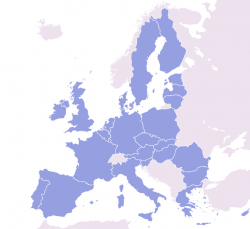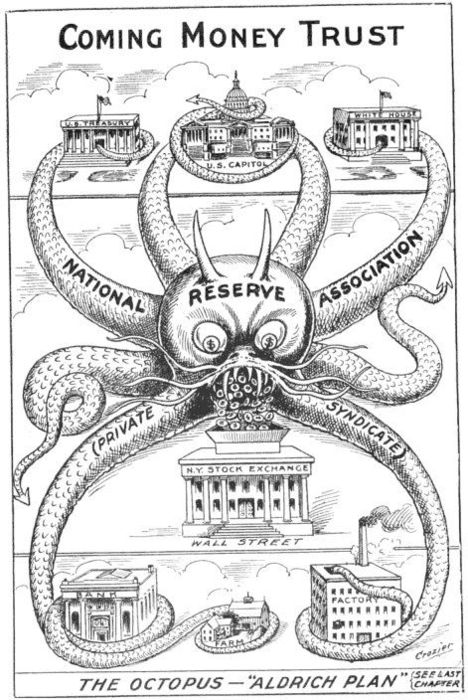 Oh, how the mighty have fallen. In just a matter of days, two of Europe’s most venerable leaders have been toppled. George Papandreou was the third member of the Papandreou dynasty to be prime minister of Greece. Silvio Berlusconi had dominated Italian politics for nearly two decades. But now they are both heading out the door and the international media have been reporting on their resignations with the kind of enthusiasm that is normally reserved for sporting events. “Down goes Papandreou! Down goes Berlusconi!” If you didn’t know better, you would almost be tempted to think that some of the recent news reports were describing a boxing match. But this is what happens when debt problems spiral out of control. It is the leaders who take the fall. So will the resignations of Papandreou and Berlusconi help anything? Of course not. Europe is still headed for a financial collapse of epic proportions.
Oh, how the mighty have fallen. In just a matter of days, two of Europe’s most venerable leaders have been toppled. George Papandreou was the third member of the Papandreou dynasty to be prime minister of Greece. Silvio Berlusconi had dominated Italian politics for nearly two decades. But now they are both heading out the door and the international media have been reporting on their resignations with the kind of enthusiasm that is normally reserved for sporting events. “Down goes Papandreou! Down goes Berlusconi!” If you didn’t know better, you would almost be tempted to think that some of the recent news reports were describing a boxing match. But this is what happens when debt problems spiral out of control. It is the leaders who take the fall. So will the resignations of Papandreou and Berlusconi help anything? Of course not. Europe is still headed for a financial collapse of epic proportions.
As I wrote about recently, it has been the fumbling of the Greek debt crisis by European leaders which has set the stage for the burgeoning financial crisis in Italy to go to a whole new level.
Once the Greek debt deal was announced, I warned that it would shatter confidence in the sovereign debt of the rest of the PIIGS and it would cause their bond yields to soar.
That is exactly what has happened.
The yield on 10 year Italian bonds (probably the most important financial number in the world at the moment) is now up to 6.7 percent.
Never before in the euro era has the yield on Italian bonds been as high as we have seen this week.
So why is this important?
Well, the reality is that Italy simply cannot afford to service its massive national debt when yields are this high.
We are officially in the danger zone.
Carl Weinberg, the chief economist at High Frequency Economics, recently said the following about what would happen if Italian bond yields go up into the 8 to 10 percent range….
“If it has to pay those yields to finance itself, Italy is dead, and the sovereign crisis just blew up”
So watch that number very carefully over the next few months.
Italy is being called “too big to fail, too big to save”. There is no way that Europe can afford Italy to crash, but there is also no way that the rest of Europe can put together enough money for a full scale bailout of Italy.
So there is panic in the air.
The Italian government is in a state of near chaos and over the past couple of weeks we have seen Berlusconi’s coalition break down. Now Berlusconi has agreed to resign, and the future of Italian politics is murky at best.
The following is how a Reuters article described the agreement for Berlusconi step down….
Berlusconi confirmed a statement from President Giorgio Napolitano that he would step down as soon as parliament passed urgent budget reforms demanded by European leaders after Italy was sucked into epicenter of the euro zone debt crisis.
The votes in both houses of parliament are likely this month and they would spell the end of a 17-year dominance of Italy by the flamboyant billionaire media magnate.
Many believe that the departure of Berlusconi is going to pave the way for brutal austerity measures to be imposed on the Italian people.
Suddenly, it very much feels like we are watching a replay of what has happened in Greece over the past couple of years. Just check out the following excerpt from a recent article in the London Evening Standard….
The Italians feel they’ve been humiliated by having to accept that monitors from the IMF will be arriving in the country this week to oversee a rise in pension ages, a sell-off of state assets and new rules to make jobs less secure.
Does that not sound like exactly what happened in Greece back near the beginning of their crisis?
In Greece, brutal austerity measures demanded by the EU and the IMF plunged the country into a depression, tax revenues plummeted, Greek debt exploded to even higher levels, bond yields soared into the stratosphere and the EU and the IMF demanded even more austerity measures be implemented.
Is the same sad story going to play out in Italy?
The Italians are definitely going to agree to some pretty significant budget cuts. But if bond yields keep rising, they are going to wipe out all of the savings from the budget cuts and then some.
This is why I keep preaching about the horror of the U.S. national debt over and over and over. If you don’t deal with it when you can, eventually interest rates rise to unbearable levels and a horror show quickly unfolds.
Anyway, right now Italy has a debt to GDP ratio of 118 percent. If they keep expanding that debt it is going to result in a financial nightmare, but if they try to implement strict austerity measures it is also going to result in a financial nightmare.
They are damned if they do and they are damned if they don’t.
Of course we should not forget about Greece.
The EU has been freaking out for quite a while about what to do about tiny little Greece.
Now that George Papandreou has been kicked to the curb, it looks like Lucas Papademos is going to be the next prime minister of Greece.
Papademos previously served as the governor of the Greek central bank, as a vice president of the European Central Bank and as a senior economist at the Federal Reserve Bank of Boston.
In other words, he would be the ideal choice of the international banking community.
Not that anyone is going to be able to do much for Greece at this point. Greece is a financial basket case, and unless someone gives them gigantic piles of money for free that is going to continue to be the case.
A year ago, the yield on 2 year Greek bonds was a bit above 10 percent. Today, the yield on 2 year Greek bonds is over 100 percent.
If you want to see what a financial meltdown looks like, just check out what is happening in Greece.
The rest of Europe is in panic mode too. For example, France is desperate to keep their AAA credit rating. In an article for the Telegraph, Ambrose Evans-Pritchard described the austerity measures that France is implementing in an attempt to head off a debt crisis of their own….
The belt-tightening plan — the second package since August, taking total cuts to €112bn — include a 5pc super-tax on big firms, a rise in VAT on restaurants and construction, and cuts on pensions, schools, health, and welfare. It is the latest squeeze in a relentless campaign of fiscal tightening across the eurozone.
In the end, all of this is too little, too late.
Europe is heading for a date with destiny. They have spent themselves into oblivion and now they are going to pay the price.
Some members of the financial community fear that a full-blown crisis could erupt at any moment. For example, according to Business Insider, Colin Tan of Deutsche Bank recently said that he believes that it is possible that “we could be in full crisis mode” by the time the week ends….
Its not inconceivable that we could be in full crisis mode by the end of this week. The situation with Italy feels increasingly like one that has little chance of materially improving until some
extreme pressure is put on someone to act. It may not come to a head this week but the signs are not good that we can avoid an extreme situation emerging soon.
For those of you that are freaking out about now, don’t worry too much. A full-blown crisis is not going to happen this week.
But time is running out.
And when Europe comes apart, it is going to have a dramatic impact on the United States as well.
According to an article in the Financial Post, the Federal Reserve made the following statement in a report about a survey that it just released….
“About one-half of domestic bank respondents, mostly large banks, indicated that they make loans or extend credit lines to European banks or their affiliates or subsidiaries”
Big U.S. banks have a lot of exposure to European debt and to European banks. When the financial dominoes start to fall, a lot of those dominoes are going to be in the United States.
One of the biggest dangers to be concerned about are all of the credit default swap contracts that U.S. banks have written on European debt. Just check out what a recent article posted on the website of MSNBC had to say about that….
U.S. banks have written about $400 billion in CDS contracts on European sovereign debt, according to the Bank for International Settlements. Those payouts would be triggered if Greece or Italy defaults. Because financial institutions are not required to report their CDS holdings, little is known about which banks or investment firms are on the hook, and for how much.
As I have written about previously, there is a very good chance that the world could be facing a massive derivatives crisis at some point in the next five to ten years.
If you hear the news talk about a “problem with derivatives” or a “derivatives crisis” then you will want to pay very close attention.
Over the past 30 years, the global financial system has constructed a gigantic mountain of debt, risk and leverage unlike anything the world has ever seen before.
At some point the whole thing is going to come crashing down.
When it does, it is going to affect the entire globe.
A huge storm is coming.
Get prepared while you can.







